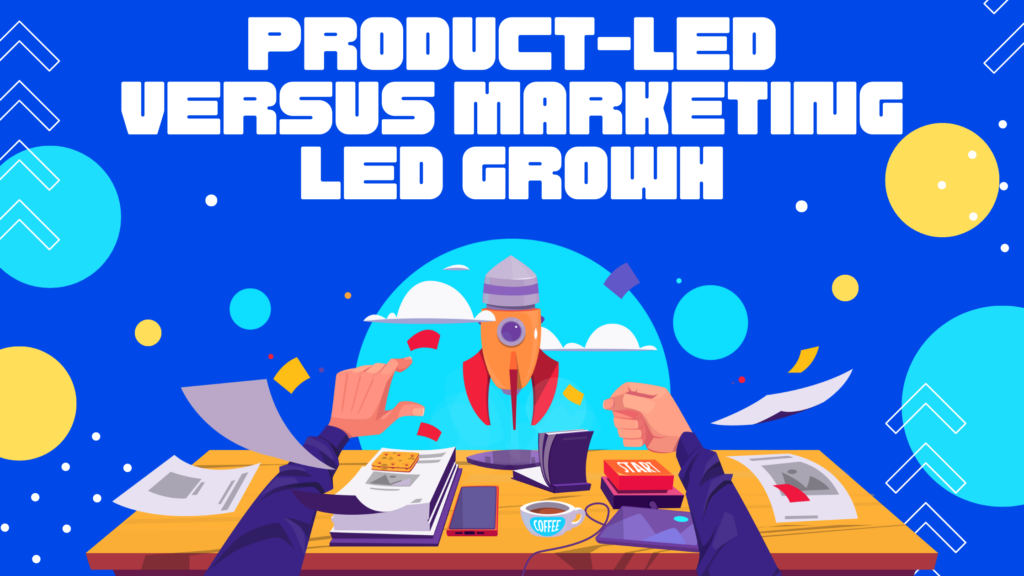In this comprehensive guide, we delve into the dynamics of Product-Led Growth (PLG) and Marketing-Led Growth (MLG), unraveling their strengths, differences, and practical applications. We also explore how businesses can strategically leverage these growth strategies to fuel their expansion.
Key Takeaways:
- PLG and MLG represent distinct but complementary growth strategies, with PLG focusing on product strengths and MLG leveraging marketing efforts.
- The choice between PLG and MLG should depend on various factors such as product nature, target market, and available resources.
- Real-world examples illustrate the successful implementation of both PLG and MLG strategies.
- A hybrid approach, leveraging the strengths of both PLG and MLG, can often be the optimal growth strategy.
- Making an informed choice between PLG and MLG can significantly impact the business’s sustainable growth trajectory.
Introduction
The realm of business growth is vast and multifaceted, housing a plethora of strategies and tactics as varied as the enterprises that employ them. Yet, amidst this diversity, two methodologies emerge with defining clarity – Product-Led Growth (PLG) and Marketing-Led Growth (MLG). These strategic frameworks represent diverging paths on the road to success, each with its distinct value proposition and implications for business trajectory.
In the contemporary corporate landscape, the choice between PLG and MLG is far from trivial; it has profound implications for a company’s identity, operation, and long-term viability. Their proper understanding and strategic application serve as twin engines that power the formidable ship of corporate success.
Through the course of this article, we will delve into the nuanced world of these growth strategies. Unpacking their definitions, dissecting their pros and cons, and shedding light on their practical applications, we aim to provide an illuminating guide for decision-makers. The analysis extends to demonstrating how Learning Management Systems, like Appsembler, can play a pivotal role in these growth strategies, effectively catalyzing your business’s trajectory toward enduring success. In doing so, we hope to equip you with the knowledge and insights necessary to steer your enterprise in a direction that aligns with your vision, leveraging the most fitting growth strategy.
Understanding Growth Strategies
Growth strategies function as the compass guiding businesses across the expansive terrains of the market landscape. By setting the pace and direction for expansion, these plans embody the vision and objectives of a company, shaping their operational and strategic decision-making processes. But what exactly are growth strategies?
In essence, growth strategies are comprehensive plans that outline how a company intends to expand its business. They are carefully designed narratives, written in the language of goals, tactics, and measurable outcomes, plotting the course from the company’s current status to its desired future state. Two prominent actors on this stage are Product-Led Growth (PLG) and Marketing-Led Growth (MLG).
PLG and MLG are not simply choices; they represent strategic philosophies that infuse themselves into every fiber of an organization. PLG puts the product at the heart of growth, leveraging its quality, functionality, and user experience as primary drivers of expansion. Conversely, MLG rests its growth narrative on the power of marketing, using persuasive communication, brand-building, and customer engagement as its growth propellants.
The act of choosing between PLG and MLG goes beyond a tactical decision; it mirrors a company’s ethos, its interpretation of value, and its relationship with customers. The selected strategy must resonate with the company’s unique characteristics, market dynamics, and customer expectations.
A Learning Management System (LMS), such as Appsembler, serves as a catalyst in this equation. As an engine of knowledge dissemination, it can streamline the implementation of either growth strategy, ensuring your product or marketing messages resonate powerfully with users and potential customers.
By understanding growth strategies and judiciously selecting between PLG and MLG, organizations can effectively architect their growth narrative, embedding the principles of continuous learning, strategic alignment, and customer value into their journey of expansion.
Product-Led Growth (PLG)
Product-Led Growth (PLG) emerges as a strategic star in the constellation of growth paradigms, embodying a fundamental shift in how companies position their offerings and engage with their markets. But what exactly is PLG?
PLG is a business methodology where the product serves as the primary vehicle for customer acquisition, conversion, and expansion. Rather than relying heavily on traditional marketing or sales efforts, businesses pursuing PLG strategies focus on creating superior products that sell themselves.
This strategy, it turns out, is not just a tactical choice—it’s a powerful statement about a company’s ethos. When a company chooses PLG, it sends a message that it believes in the inherent value of its products. It communicates the conviction that the product can stand alone in the market, win customers over, and ultimately, fuel growth.
The importance of PLG cannot be overstated in an era where customers are increasingly research-driven, expecting high-quality user experiences. A Learning Management System, such as Appsembler, can leverage PLG to demonstrate its value proposition through its robust features and intuitive interface, thereby attracting, satisfying, and retaining users.
Indeed, PLG offers businesses the prospect of sustainable growth, centered around products that not only meet but exceed customer expectations, thereby cultivating customer loyalty and fostering long-term success.
Marketing-Led Growth (MLG)
In the intriguing narrative of growth strategies, Marketing-Led Growth (MLG) takes center stage, painting a compelling picture of how persuasive storytelling can shape the fortunes of a company. But what constitutes MLG?
MLG is a growth strategy that harnesses the power of marketing to drive business expansion. It places a spotlight on customer engagement, brand perception, and the effective communication of value. Rather than the product steering the ship, marketing sits at the helm in an MLG approach, guiding the enterprise towards growth.
A choice for MLG reflects a company’s belief in the power of storytelling, the persuasion of branding, and the impact of customer relationships. It’s an acknowledgement of the consumer’s role not just as a user of a product, but as an influencer, an advocate, and a partner in the business’s journey.
The significance of MLG is magnified in a market landscape where customer opinions and brand perceptions can significantly influence business success. In the context of a Learning Management System like Appsembler, a robust MLG strategy can help shape positive perceptions, stimulate customer interest, and foster loyalty.
In essence, MLG represents the interplay of marketing acumen and business growth, where customer connections and brand narratives propel the organization forward, carving its path in the competitive marketplace.
Comparing Product-Led Growth and Marketing-Led Growth
In the enthralling theatre of business strategies, Product-Led Growth (PLG) and Marketing-Led Growth (MLG) emerge as lead actors, each presenting compelling narratives about growth and expansion. Both embody distinct philosophies and implications, painting the canvas of strategic decision-making with different hues.
Product-Led Growth, as the name suggests, places the product as the epicenter of the growth narrative. This strategy believes in the inherent power of the product to sell itself, converting users into customers, and customers into advocates. PLG relies on crafting high-quality, user-friendly products that naturally attract, retain, and expand the user base. For instance, a Learning Management System like Appsembler, delivering an outstanding user experience, intuitive features, and robust functionality, can draw customers and foster loyalty, driving growth in a product-led manner.
However, PLG isn’t without its challenges. The emphasis on product superiority means continuous investment in product development, staying ahead of the competition, and maintaining a seamless user experience. In a rapidly evolving marketplace, this could pose considerable pressure and potential risk.
On the other hand, Marketing-Led Growth places marketing and customer engagement at the core of the growth strategy. MLG focuses on crafting persuasive brand stories, building strong customer relationships, and effectively communicating the product’s value proposition. A potent MLG strategy could position even a mundane product as a desirable purchase, solely through the power of marketing.
However, MLG, too, carries its share of drawbacks. A sole reliance on marketing might divert focus from product quality, leading to potential customer dissatisfaction. Also, a heavy marketing investment without a commensurate focus on product enhancement might result in a lack of long-term sustainability.
When comparing PLG and MLG, it’s crucial to remember that neither strategy is inherently superior. The choice between PLG and MLG hinges on a multitude of factors, including the nature of the product, market dynamics, company’s resources, and customer expectations.
For products with a clear, distinct competitive advantage and high user engagement, such as innovative tech platforms or unique software solutions, PLG might be the preferred route. Here, the product itself can serve as the most compelling marketing tool.
In contrast, for markets with similar product offerings and intense competition, a robust MLG strategy can help differentiate a brand and create a unique space in the customer’s mind. It’s also especially effective when the company has a strong marketing team and resources.
In conclusion, the debate between Product-Led Growth and Marketing-Led Growth isn’t about choosing one over the other universally. It’s about understanding the strengths and weaknesses of each approach, analyzing the context, and making an informed decision that aligns best with the company’s vision, product, and market position. The real mastery lies in leveraging the best of both worlds, crafting a tailored growth strategy that captures the product’s strength and the power of marketing. In the world of business strategies, one size certainly does not fit all.
Case Studies: PLG vs MLG
In the engaging narrative of growth strategies, real-world instances provide valuable insights. Let’s take a look at some examples of successful implementations of Product-Led Growth (PLG) and Marketing-Led Growth (MLG).
Slack, a prominent name in business communication, is an exemplary PLG success story. The company’s philosophy of “be less busy” is ingeniously incorporated into its product. With a clean, user-friendly interface, powerful integrations, and an overall emphasis on improving team collaboration, Slack leverages its product’s strengths to drive growth. Users are pulled into the ecosystem through its rich feature set and stay for the convenience it adds to their work lives.
Contrastingly, Nike demonstrates an exemplary execution of MLG. While Nike does manufacture high-quality athletic gear, it’s the brand’s marketing efforts that truly set it apart. The “Just Do It” campaign is not just about selling shoes; it’s about promoting an active lifestyle, perseverance, and personal achievement. The result? A brand perception that transcends the physical product, resonating with customers on a deeper, more personal level.
However, remember the role Learning Management Systems like Appsembler can play in both approaches. In a PLG scenario, its superior features and user-friendly design make the product attractive to potential users. In an MLG approach, marketing efforts can highlight the system’s capabilities, effectively communicating the value proposition to potential customers.
These case studies underline the fact that both PLG and MLG can be instrumental in driving business growth. The choice between them depends largely on the company’s unique circumstances, the nature of the product, and the characteristics of the target market. The key is to strike a balance that leverages the strengths of both strategies, thereby ensuring sustainable growth and success.
Appsembler: Facilitating Growth Strategies
Appsembler represents a shining example of a Learning Management System (LMS) that brings together the best of both worlds—Product-Led Growth (PLG) and Marketing-Led Growth (MLG)—to offer a compelling value proposition to its customers.
This cloud-based, user-friendly platform offers a comprehensive solution for businesses, educators, and organizations seeking to streamline their training and educational processes. With a plethora of features ranging from content creation and course management to analytics and integrations, Appsembler asserts its strength in its product, thereby supporting a PLG strategy.
Appsembler’s robust feature set, excellent user experience, and its commitment to continuous innovation serve as its primary drivers of customer acquisition and retention. As users explore and engage with its numerous features, they become ambassadors for the product, thereby creating a virtuous cycle of growth.
Simultaneously, Appsembler’s potential for an effective MLG strategy is inherent in its versatile functionality. By communicating its value proposition effectively—whether it’s the platform’s ease-of-use, its ability to streamline and enhance learning processes, or its analytical capabilities—Appsembler can resonate with potential customers and stakeholders.
Its branding as a reliable, comprehensive, and user-friendly LMS solution creates a persuasive narrative that can attract and engage customers. By leveraging both product excellence and compelling marketing, Appsembler can drive growth and expansion.
The advantages of using Appsembler extend beyond its PLG and MLG potential. With its intuitive interface, scalability, and robust support, Appsembler simplifies the learning management process, whether you’re an educational institution, a business, or an organization. It ensures a seamless and enriching learning experience, making it an ideal ally in your journey towards growth and success.
In essence, Appsembler epitomizes how an LMS can leverage the strengths of both PLG and MLG to carve a unique space in the competitive marketplace. The choice isn’t between product and marketing—it’s about orchestrating them in harmony, and Appsembler beautifully illustrates this symphony.
Choosing Between PLG and MLG: A Guideline
Choosing between Product-Led Growth (PLG) and Marketing-Led Growth (MLG) isn’t about picking one over the other in a vacuum—it’s a strategic decision that should be guided by a nuanced understanding of your product, market, resources, and vision.
The first factor to consider is the nature of your product. If it has distinct features or competitive advantages that set it apart from the competition—like Appsembler with its user-friendly interface and robust features—a PLG strategy can leverage these strengths to drive growth.
On the other hand, if your product operates in a saturated market with minimal differentiation, an MLG strategy could be a game-changer. By crafting compelling narratives, building strong customer relationships, and communicating the product’s value proposition effectively, you can carve a unique space in the market and drive growth.
The resources at your disposal also play a crucial role. A robust marketing team and budget would favor an MLG approach, while a stellar product development team could lean towards a PLG strategy. Additionally, customer expectations and behavior patterns in your target market should guide your choice. A tech-savvy user base, for instance, might respond more favorably to a superior product, favoring PLG.
Remember, the ultimate goal isn’t to choose between PLG and MLG—it’s to align your growth strategy with your business reality. It might even make sense to adopt a hybrid approach, leveraging the strengths of both strategies. The key is to stay flexible, keep testing, and evolve your strategy as per the market feedback and business performance.
In conclusion, choosing between PLG and MLG is a strategic decision that should be guided by a thorough understanding of your product, market, and resources. By aligning your strategy with these factors, you can harness the strengths of both PLG and MLG to drive sustainable growth.
Conclusion
In the realm of growth strategies, neither Product-Led Growth (PLG) nor Marketing-Led Growth (MLG) reigns supreme—they both have unique merits and applicability. While PLG leverages the strengths of the product itself to fuel expansion, MLG uses compelling narratives and brand perception to secure customer loyalty and drive sales.
Your strategic choice should depend on a range of factors, from the nature of your product and target market to the resources at your disposal. The compelling case of Appsembler shows us that the real sweet spot often lies in leveraging the strengths of both approaches to create a unique, cohesive growth strategy.
As the marketplace evolves and competition intensifies, understanding and harnessing both these strategies could be instrumental in driving sustainable growth. Remember, the goal is not to choose between product and marketing, but to orchestrate them in harmony to create a symphony of sustainable business growth.
Frequently Asked Questions
Product-led growth (PLG) is a business strategy where the product itself serves as the main driver of customer acquisition, conversion, and expansion. In contrast, marketing-led growth (MLG) relies on marketing efforts, such as brand building, communication strategies, and customer relationships, to drive business growth.
Yes, you can. Many successful businesses employ a hybrid approach, leveraging the strengths of both PLG and MLG strategies. The choice depends on various factors, including the nature of your product, target market, and available resources.
Slack, with its user-friendly interface, powerful features, and integrations, is a classic example of a PLG business. The product’s inherent strengths drive its growth.
Nike’s growth is primarily driven by its marketing strategies. Their campaigns transcend beyond selling athletic gear to promoting lifestyle, resilience, and personal achievement, thereby resonating with customers at a deeper level.
Appsembler supports PLG through its superior features and user-friendly design, making it an attractive option for users. On the other hand, its potential for MLG is realized through marketing efforts that effectively communicate the system’s capabilities, ensuring a strong value proposition for potential customers.
Choosing between PLG and MLG should depend on a nuanced understanding of your product, market, resources, and vision. Factors such as product differentiation, market saturation, available resources, and customer behavior should guide your choice. In many cases, a hybrid approach might be the best course of action.
Absolutely. With a Learning Management System like Appsembler, you can highlight superior features and user-friendly design (PLG) while also using effective marketing strategies to communicate its benefits and capabilities (MLG), resulting in a balanced growth strategy.



